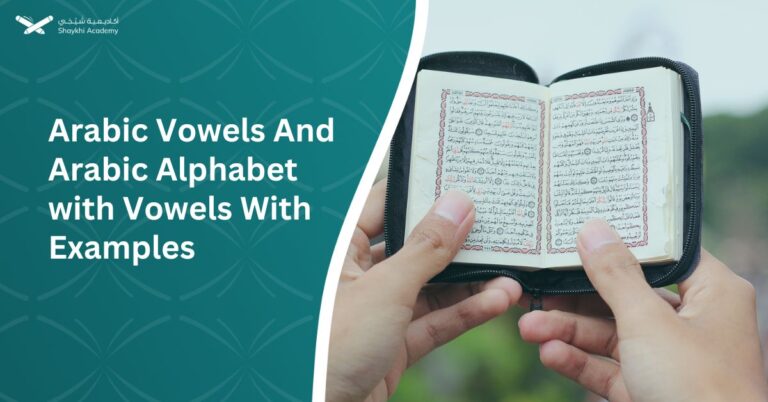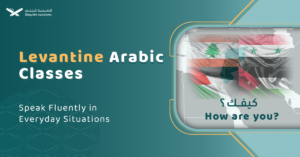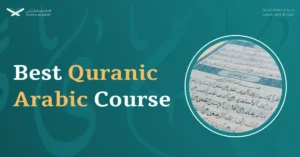Some grammatical rules from different languages resemble each other. Verbal nouns in Arabic resemble gerunds in English. It’s a rule you should know to learn how to express various thoughts, actions, or ideas.
In this article, we will show you the verbal nouns in Arabic, how to create them, their types, and what courses you can enroll in to help you improve your grammatical level in Arabic.
Definition of Arabic Verbal Noun (Esm Al-Masdar):
Arabic verbal noun, or “اسم المصدر” (Esm al-masdar), is a verb-derived noun that has the meaning of the verb but without defining a specific tense.
When using a verbal noun instead of a verb, the verbal noun expresses actions or emphasizes them. It’s also used to show habitual or continuous actions or to give a notion about something without a specific timeline.
Types of Verbal Nouns:
Verbal nouns are divided into multiple types according to the usage of each one of them like expressing abstract concepts or indicating doing something for one time.
1. The Crafted Masdar:
The crafted masdar, or “المصدر الصناعي” (Al-masdar al-senae’y), is a type of verbal nouns used to express a meaningful idea about some concepts like political or religious ones.
| Verb | Verbal Noun | Meaning |
| “حَبّ” (Habb) | “حُبّ” (Hobb) | “Love” |
| “أسلم” (Aslam) | “إسلام” (Eslam) | “The Islam” |
| “ثار” (Thar) | “ثورة” (Thawra) | “Revolution” |
2. The Verbal Noun of Manner:
The verbal noun of manner, or “اسم الهيئة” (Esm al-hay’ah), is another type of verbal nouns used to express the idea of how the action was done. It’s only used with the form I with the pattern “فِعْلَة” (Fe’lah)
| Verb | Verbal Noun | Meaning |
| “جرى” (Jara) | “جري” (Jary) | “Running” |
| “قَفَز” (Qafaz) | “قَفْز” (Qafz) | “Jumping” |
3. The Parent Masdar And The Original Masdar:
The parent masdar, or “اسم المصدر” (Esm al-masdar), and the original masdar, or “المصدر الأصلي” (Al-masadr al-asly), are considered two sides of the same coin. They refer to the same type of verbal nouns, which are directly driven from the verb without modifications.
The difference is the original masdar is focused on the unmodified form, while the parent masdar is a basic simple form that is considered a starting point for more complicated verbal noun types like the crafted one.
| Verb | Parent Masdar | Original Masdar | Meaning |
| “فاز” (Faz) | “فوز” (Fawz) | “فوز” (Fawz) | “Victory” |
| “قاتل” (Qatal) | “قتال” (Qetal) | “قتال” (Qetal) | “Fighting” |
4. The Verbal Noun of One Time:
The verbal noun of one time, or “اسم المرة” (Esm el-marra), is a kind of verbal nouns used to describe an action that has been done just once. It is formed by adding “ة” (Taa’ Marbootah) at the end of simple or complicated forms. It can be dual or plural.
| Verb | Verbal Noun | Meaning |
| “ابتسم” (Ebtasam) | “ابتسامة” (Ebtesamah) | “A smile” |
| “قَفَز” (Qafaz) | “قَفْزة” (Qafzah) | “One jump” |
If the form already ends with “ة” (Taa’ Marbootah), we can’t add one more to create the verbal noun of one time, we add the word “واحدة” (Wahedah) instead of that.
For example, the form “زيارة” (Zeyarah), or “Visiting”, is a verbal noun ending with “ة”, it turns to “زيارة واحدة” (Zeyarah wahedah), or “One visit”, to become a verbal noun of one time.
5. The Miim Masdar:
The miim masdar, or “المصدر الميمي” (Al-masdar al-miimy), is another type of verbal nouns characterized by the letter “م” (miim) at the beginning of it with fatha harakah on it. It resembles the original masdar in significance but with more strength, and it always has a masculine gender.
For Example, the verb “شرب” (Shareb), which means “Drank”, turns to “مَشرَب” (Mashrab), which means “a place where you can drink something”.

Book your free trial now!
Arabic Verbal Noun Forms (Awzan):
You should understand the different forms of verbal nouns to know how to create and use them in various sentences. Verbal noun forms are like patterns to be followed for verbs similar in pronunciation.
To form verbal nouns you should learn how to manipulate the root of the verb, maybe by lengthening some vowels or by adding extra letters. You may also use some diacritics, or “علامات التشكيل” (A’lamat al-tashkil), to create the verbal noun in patterns, or “أوزان” (Awzan).
1) Form I “Samae’ya”:
In Form I, verbs don’t have a specific pattern or rule, or we might say that it has a wide scattered variety of patterns, you know it by practicing and hearing more and more in Arabic. That’s why we call it “سماعية” (Samae’ya) in Arabic, and it means “by hearing”.
For Example, “فَعَلَان” (Fa’alaan) pattern. The verbal noun of the verb “غلى” (Ghala) is “غليان” (Ghalayan) which means “Boiling”.
Another example is “فِعَالَة” (Fe’aalah) pattern. The verbal noun of the verb “كتب” (Katab) is “كتابة” (Ketabah) which means “Writing”.
2) Form II “Fa’aal”:
In Form II, where the verb itself follows the pattern “فَعَّل” (Fa’aal), there are two patterns to create verbal nouns: “تَفْعِيل” and “تَفْعِلة”.
For Example, “تَفْعِيل” (Tafe’eel) pattern. The verbal noun of the verb “درب” (Darrab) is “تدريب” (Tadreeb) which means “Training”.
Another example is “تَفْعِلة” (Tafe’ela) pattern. The verbal noun of the verb “جرب” (Jarrab) is “تجربة” (Tajreba) which means “Experiment”.
3) Form III “Faa’al”:
In Form III, where the verb itself follows the pattern “فَاعَل” (Faa’al), there are two patterns to create verbal nouns: “مُفاعَلة” and “فِعَال”.
For Example, “مُفاعَلة” (Mofa’alah) pattern. The verbal noun of the verb “زاول” (Zawal) is “مزاولة” (Mozawalah) which means “Practicing”.
Another example is the “فِعَال” (Fe’aal) pattern. The verbal noun of the verb “جاور” (Jawar) is “جوار” (Jewar) which means “Neighboring”.
4) Form IV “Afa’al”:
In Form IV, where the verb itself follows the pattern “أفعلَ” (Afa’al), there is one pattern to create verbal nouns, which is “إفْعال”. This form is considered causative of verb form I, which means making someone do what verb form I refers to.
For Example, “إفْعال” (Efa’aal) pattern. The verbal noun of the verb “ألهم” (Alham) is “إلهام” (Elham) which means “Inspiration”.
5) Form V “Tafa’al”:
In Form V, where the verb itself follows the pattern “تفعل” (Tafa’al), there is one pattern to create verbal nouns, which is “تَفَعُّل”. This form is considered reflexive to verb form II, which means making oneself do what verb form II refers to.
For Example, “تَفَعُّل” (Tfa’ol) pattern. The verbal noun of the verb “تكبر” (Tkabbar) is “تكبر” (Tkabbor) which means “Arrogance”.
Enroll in the Online Al Azhar Arabic Course to learn about verbal nouns in more detail and for further knowledge to master Arabic grammar.
Or you may join the Arabic Grammar Course as a starting point for learning the basics of Arabic grammar.

Book your free trial now!
6) Form VI “Tafaa’al”:
In Form VI, where the verb itself follows the pattern “تفاعل” (Tafaa’al), there is one pattern to create verbal nouns, which is “تَفاعُل”. This form is considered reflexive to verb form III, which means making oneself do what verb form III refers to.
For Example, “تَفاعُل” (Tfaa’ol) pattern. The verbal noun of the verb “تحاور” (Thaawar) is “تحاور” (Thaawor) which means “Interaction”.
7) Form VII “Enfa’al”:
In Form VII, where the verb itself follows the pattern “انفعل” (Enfa’al), there is one pattern to create verbal nouns, which is “اِنْفِعال”.
For Example, “اِنْفِعال” (Enfe’aal) pattern. The verbal noun of the verb “انفجر” (Enfajar) is “انفجار” (Enfejaar) which means “Explosion”.
8) Form VIII “Efta’al”:
In Form VIII, where the verb itself follows the pattern “افتعل” (Efta’al), there is one pattern to create verbal nouns, which is “اِفْتِعال”.
For Example, “اِفْتِعال” (Efte’aal) pattern. The verbal noun of the verb “ابتهج” (Ebtahaj) is “ابتهاج” (Ebtehaaj) which means “Rejoicing”.
9) Form IX “Efa’all”:
In Form IX, where the verb itself follows the pattern “افعل” (Efa’all), there is one pattern to create verbal nouns, which is “اِفْعِلال”.
For Example, “اِفْعِلال” (Efe’lal) pattern. The verbal noun of the verb “انحل” (Enhall) is “انحلال” (Enhelal) which means “Dissolution”.
10) Form X “Estfa’al”:
In Form X, where the verb itself follows the pattern “استفعل” (Estfa’al), there is one pattern to create verbal nouns, which is “اِسْتِفْعال”. This form is considered reflexive or causative of verb form IV, which means making oneself or someone else do what verb form IV refers to.
For Example, “اِسْتِفْعال” (Estefa’aal) pattern. The verbal noun of the verb “استخدم” (Estakhdam) is “استخدام” (Estekhdam) which means “Usage”.

Book your free trial now!
Read more about: Dual Nouns In Arabic
Learn More about Arabic Grammar with Azhari Tutors at Shaykhi Academy:
One of the best experiences you are going to have is joining the Online Al Azhar Arabic Course at Shaykhi Academy. This course is a great opportunity to learn Arabic grammar with Azhari native supportive tutors.
This course helps you understand more about Arabic literature, calligraphy, and spelling rules as well, so that at the end of this course you will be able to master the Arabic grammar, use correct spelling, and understand Arabic texts easily.
It’s organised so that you learn in the most comfortable encouraging possible way, so that you enjoy learning and learn fast with your suitable curriculum according to your lifestyle.
Why Shaykhi Academy?
- Expert Native Tutors: Learn from highly qualified native Arabic speakers.
- Flexible Scheduling: Tailor your classes to fit your busy life.
- Affordable Learning: Access top-quality education at a price that suits you.
- Global Access: Study from anywhere in the world.
Explore Our Arabic Courses:
- Noorani Qaida: Build a strong foundation in Quranic Arabic.
- Comprehensive Arabic Courses: Master the Arabic language, from beginner to advanced levels.
- Fusha Arabic Classes: Delve into Modern Standard Arabic, the key to understanding literature, media, and formal communication across the Arab world.
- Quranic Arabic Course: Enhance your connection with the Quran by learning the language in which it was revealed.
Start Your Arabic Journey Today! Whether you’re just starting or looking to deepen your knowledge, Shaykhi Academy is here to support your journey. Book your free trial now and begin your path to Arabic mastery!

Conclusion
In Arabic, verbal nouns are nouns derived from verbs and produce the same meaning, but the rules of verbs do not apply to them. It is created using patterns, or “أوزان” (Awzan), according to the verb forms, And there are multiple types of verbal nouns according to usage.
Understanding this grammatical rule enhances your ability to express ideas and actions more deeply, and it will also help you understand more complicated Arabic texts. It will enrich your vocabulary as well.














































